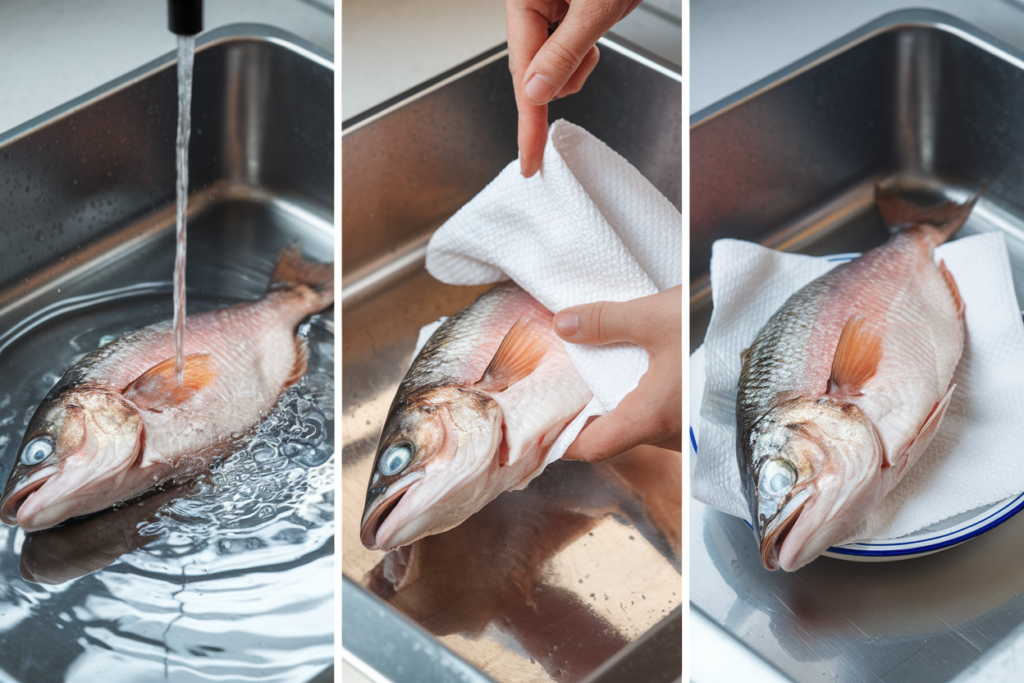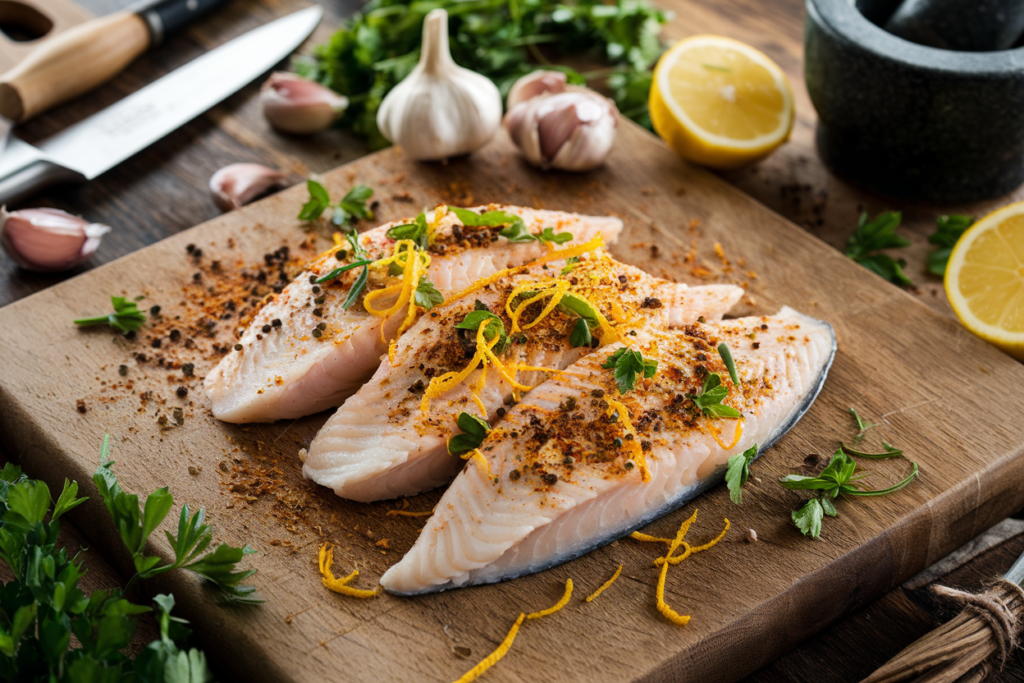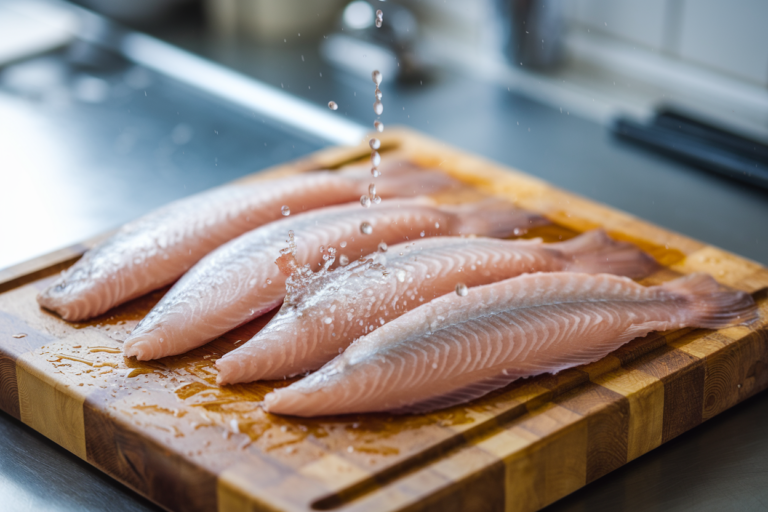Introduction to Tilapia Preparation
When preparing tilapia, one question frequently arises: Should you rinse tilapia before cooking? This query is essential for many home cooks who wonder if rinsing is necessary for cleanliness and flavor. Some ask, Is rinsing tilapia necessary before cooking? or Do you need to wash tilapia before cooking? Others ponder, Should tilapia be cleaned before cooking? and Is it important to rinse tilapia before preparing? Understanding whether tilapia needs to be washed prior to cooking or if it’s essential to rinse tilapia before you cook it can impact your cooking process. In this article, we’ll explore expert opinions and best practices to help you determine the best way to prepare tilapia.
In this article, we’ll dive deep into the best practices for tilapia preparation, examining expert advice, common methods, and alternative techniques to help you make an informed decision.
For alternatives and additional techniques, check out our Homemade Eskimo Pie Popsicle Recipe which offers creative solutions for achieving the desired results in various dishes.
Understanding the Basics of Tilapia Preparation
Before cooking tilapia, it’s essential to understand the fundamental steps involved in preparing this fish. Unlike other types of fish, tilapia has a delicate texture, which makes it more susceptible to damage during the preparation process. Proper handling and cleaning are crucial to preserving its flavor and ensuring a delightful dining experience.
Traditionally, many cooks prefer to rinse tilapia under cold water before cooking. This practice is often recommended to remove any residual scales, slime, or impurities that may be present on the fish’s surface. However, not everyone agrees on this method, as some argue that rinsing can spread bacteria in your kitchen and potentially compromise food safety.
Aqua Best Seafood – How to Clean Tilapia offers a step-by-step guide on the proper methods for cleaning and preparing tilapia, emphasizing the importance of thorough preparation.
Cleaning and preparing ingredients properly is crucial, as highlighted in Artisan Lettuce Salads: The Secret to Stunning Nutritious Salads. If you’re looking for methods to enhance flavor and texture, our Zucchini Banana Bread recipe provides valuable insights. Additionally, common mistakes in preparation can be avoided by referring to our Artichoke and Parmesan Tilapia Recipe.
Rinsing vs. Not Rinsing: What the Experts Say
When it comes to rinsing tilapia, opinions are divided. On one side, some chefs and home cooks argue that rinsing the fish before cooking is a necessary step to ensure cleanliness and enhance the fish’s flavor. They believe that rinsing removes any unwanted residues, such as slime or blood, that might affect the taste.
Conversely, others contend that rinsing tilapia is unnecessary and may even be counterproductive. According to these experts, the cooking process itself—whether grilling, frying, or baking—effectively eliminates any bacteria or impurities that might be present on the fish’s surface. Additionally, rinsing can cause water to splash around the kitchen, spreading bacteria to other surfaces.
As mentioned by Home Cook World – Should You Rinse Fish Before Cooking?, it’s crucial to consider both food safety and flavor when deciding whether or not to rinse tilapia. Ultimately, the choice may come down to personal preference and the specific recipe you’re following.
Step-by-Step Guide to Rinsing Tilapia Properly
If you decide that rinsing tilapia is the right choice for you, it’s essential to do it correctly to avoid cross-contamination and ensure the best results. Here’s a detailed guide to help you rinse tilapia like a pro:
- Prepare the Sink: Before you begin, make sure your sink is clean and free of any dishes or debris. This will help prevent cross-contamination.
- Handle the Fish with Care: Place the tilapia fillets or whole fish under cold running water. Gently rub the fish’s surface to remove any visible impurities, such as scales or slime.
- Avoid Overhandling: Be careful not to overhandle the fish, as tilapia’s delicate texture can easily break apart if you’re too rough.
- Dry the Fish Thoroughly: After rinsing, use paper towels to pat the tilapia dry. This step is crucial, especially if you plan to cook the fish using methods like frying or grilling, as excess moisture can interfere with achieving a crispy texture.
For more on tilapia preparation, check out Eat With Us – How Do You Clean Tilapia Before Cooking?, which offers additional tips and advice on handling this versatile fish.

Alternatives to Rinsing Tilapia
While rinsing is a common practice, there are alternative methods to prepare tilapia without rinsing it under water. These techniques can be just as effective in ensuring a clean and flavorful dish:
- Brining: Soaking tilapia in a brine solution (water and salt) for a short period can help enhance the flavor and texture without the need for rinsing.
- Marinating: Marinating tilapia in a mixture of herbs, spices, and acidic ingredients like lemon juice or vinegar can help eliminate any unwanted odors and impart additional flavor.
- Patting Dry: If you’re concerned about cross-contamination, simply patting the tilapia dry with paper towels before cooking can be a safe and effective alternative.
These methods offer a range of options depending on your cooking style and preferences, allowing you to prepare tilapia without the need for rinsing.
Common Mistakes to Avoid When Preparing Tilapia
When preparing tilapia, even small mistakes can affect the final dish’s taste and texture. Here are some common pitfalls to avoid:
- Overhandling the Fish: Tilapia is delicate, and excessive handling can cause it to break apart. Always handle it gently, especially during rinsing or drying.
- Improper Thawing: If you’re working with frozen tilapia, make sure to thaw it properly. Avoid thawing it at room temperature, as this can promote bacterial growth. Instead, thaw it in the refrigerator or under cold running water.
- Skipping the Drying Step: Whether you rinse your tilapia or not, always pat it dry before cooking. This step is crucial for achieving a desirable texture, particularly if you’re frying or grilling the fish.
By avoiding these mistakes, you’ll ensure that your tilapia dish turns out perfectly every time.
The Impact of Rinsing on the Taste of Tilapia
Rinsing tilapia can have a noticeable impact on its flavor, depending on how the fish is cooked and seasoned. Here’s how rinsing might affect your dish:
- Enhanced Freshness: Rinsing can remove any lingering odors or slimy residue, resulting in a fresher-tasting fish.
- Improved Flavor Absorption: Removing excess moisture after rinsing allows tilapia to absorb marinades or seasonings more effectively, enhancing the overall flavor.
- Texture Considerations: If not dried properly after rinsing, the tilapia may steam rather than sear, leading to a less desirable texture, particularly if you’re aiming for a crispy finish.
For a deeper dive into the impact of rinsing on fish flavor, refer to Home Cook World – Should You Rinse Fish Before Cooking?, which explores this topic in greater detail.
Cooking Techniques That Don’t Require Rinsing
Certain cooking methods can eliminate the need for rinsing tilapia altogether, allowing you to focus on enhancing the fish’s natural flavors:
- Grilling: Grilling tilapia at high heat can effectively kill bacteria and achieve a smoky, charred flavor without the need for rinsing.
- Baking: Baking tilapia in a preheated oven helps lock in moisture and cook the fish evenly, making rinsing unnecessary.
- Frying: If you’re frying tilapia, a thorough pat-down with paper towels is often sufficient to remove surface moisture, allowing the fish to achieve a crisp, golden-brown crust.
These methods not only simplify the preparation process but also help you achieve the best possible flavor and texture in your tilapia dishes
Best Practices for Storing Tilapia After Rinsing
If you choose to rinse your tilapia, it’s crucial to store it properly to maintain its freshness and prevent contamination. Follow these best practices for storing rinsed tilapia:
- Refrigeration: After rinsing, immediately store the tilapia in the refrigerator. Place it in an airtight container or wrap it tightly in plastic wrap or aluminum foil to prevent exposure to air and moisture. It’s best to consume the fish within 1-2 days for optimal freshness.
- Freezing: If you’re not planning to cook the rinsed tilapia right away, freezing is an excellent option. Pat the fish dry after rinsing, then wrap it in plastic wrap or aluminum foil, followed by a layer of freezer paper. This double layer will help protect the fish from freezer burn. Tilapia can be stored in the freezer for up to 3 months.
- Avoid Re-rinsing: Once tilapia has been rinsed and stored, avoid re-rinsing before cooking, as this can increase the risk of contamination and affect the fish’s texture.
For more detailed storage guidelines, refer to FoodSafety.gov – Food Storage Charts, which provides comprehensive advice on storing various types of fish.
Expert Tips for Enhancing Tilapia Flavor Without Rinsing
If you prefer not to rinse your tilapia, there are several techniques you can use to enhance its flavor and ensure a delicious dish:
- Seasoning: Generously season the fish with herbs, spices, and citrus zest before cooking. This will help mask any slight fishy odor and bring out the natural flavors of the tilapia.
- Cooking with Aromatics: Cook tilapia with fresh garlic, onions, and herbs to infuse the fish with additional layers of flavor. These ingredients can be added directly to the pan when baking or sautéing the fish.
- Using Acidic Ingredients: Marinating tilapia in lemon juice, vinegar, or a mixture of both before cooking can help to neutralize any unwanted odors and add brightness to the dish.
For more flavor-enhancing ideas, check out The Spruce Eats – How to Cook Tilapia, which offers a variety of recipes and techniques to make your tilapia stand out.

Frequently Asked Questions About Rinsing Tilapia
To help you make an informed decision about whether to rinse tilapia before cooking, here are answers to some common questions:
- Is it safe to rinse tilapia before cooking?
Rinsing tilapia is generally considered safe if done correctly, but it’s important to avoid cross-contamination. Always clean and sanitize the sink and surrounding areas after rinsing fish. - Does rinsing tilapia affect its taste?
Rinsing tilapia can remove any residual odors and improve its taste, but if not dried properly, it may affect the texture of the cooked fish. - What are alternatives to rinsing tilapia?
Alternatives to rinsing include brining, marinating, or simply patting the fish dry with paper towels.
For more insights into these common concerns, visit EatingWell – Should You Rinse Fish Before Cooking?, which provides a detailed exploration of this topic.
Conclusion: To Rinse or Not to Rinse?
The decision to rinse tilapia before cooking ultimately comes down to personal preference and the specific recipe you’re following. While rinsing can help remove unwanted residues and improve the fish’s taste, it’s not always necessary, especially if you follow proper handling and cooking techniques.
If you choose to rinse, be sure to do so safely, avoiding cross-contamination, and drying the fish thoroughly afterward. Alternatively, consider using other methods like brining or marinating to achieve similar results without rinsing.
Whether you rinse or not, the key to a delicious tilapia dish lies in the quality of the fish and the care taken during preparation and cooking. With these expert tips and techniques, you can confidently prepare tilapia that is both safe and flavorful.
For more information on this topic, refer to the resources linked throughout this article and explore additional expert advice on Cooking Light.

